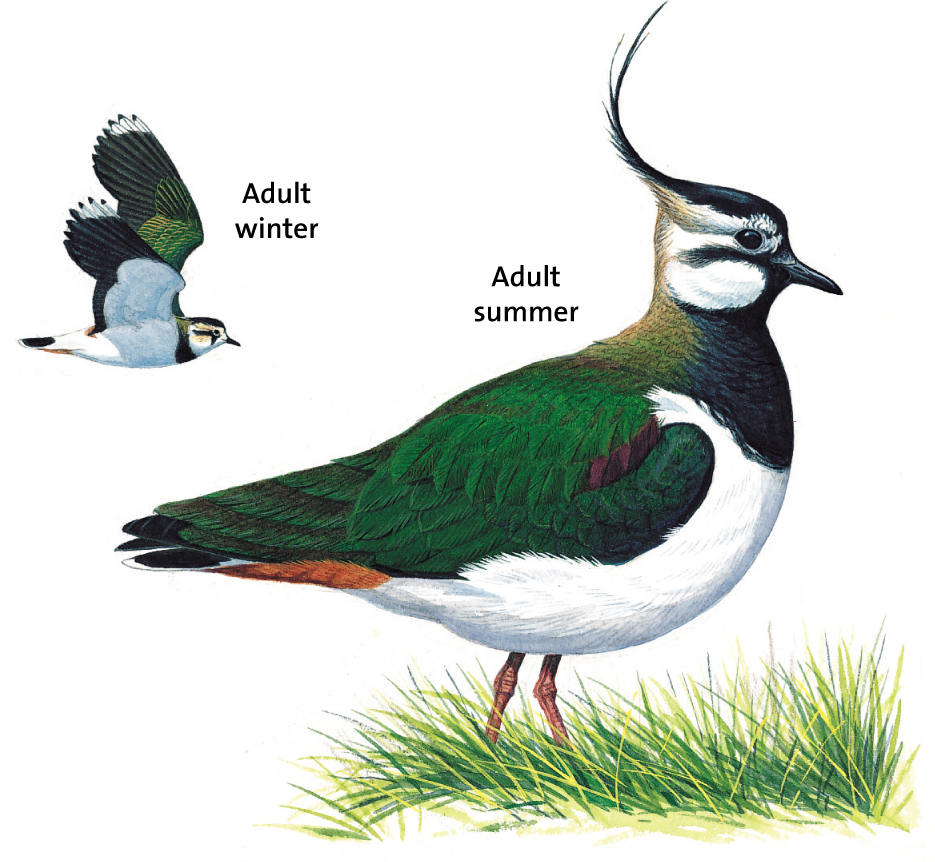
Little Ringed Plover
Charadrius dubius

SIZE AND DESCRIPTION
16cm. Very similar to Ringed Plover, but less common, and adults have a golden eyering, duller straw-coloured legs and a black bill. No narrow white wingbar.
VOICE
Calls a whistling ‘tiu’. Display or flight call a rough rolling ‘chrechrechrechre’.
HABITAT
Inland marshes, lakes and gravel pits. Summer visitor to most of Europe. In Britain fairly common in south, but absent from north.
FOOD AND HABITS
Diet consists mainly of insects, as well as spiders, freshwater shrimps and other small crustaceans. Nest a shallow scrape on loose sand, dry mud or rocks, or in sparse vegetation, near water.
Ringed Plover
Charadrius hiaticula

SIZE AND DESCRIPTION
19cm. Common shore bird with a black mask and breast band, and a white collar and forehead. Upperparts brown, underparts white. Narrow white wingbar. Black markings more subdued in winter than in summer.
VOICE
Calls a liquid ‘tooi’ and ‘kluup’. Trilling song.
HABITAT
Resident in Britain. Breeds on beaches and mudflats; also lake edges or tundra, sometimes inland, in north. Winters mainly on rocky and muddy coasts in western Europe.
FOOD AND HABITS
Mainly eats insects, worms and molluscs, and some plant matter. Nests in a shallow scrape on the ground.
Golden Plover
Pluvialis apricaria

SIZE AND DESCRIPTION
28cm. Breeding plumage spangled yellow and brown, with black throat and belly, northern birds being more boldly marked. Outside breeding season black on underparts is absent.
VOICE
Liquid whistling call, ‘tlui’. Song a liquid ‘too-roo, too-roo’.
HABITAT
Rare breeding bird of upland moor, mainly in northern Britain. In winter widespread and much commoner, mainly found on coastal grassland and grazing marsh.
FOOD AND HABITS
Eats mostly insects, molluscs and some plant matter. Nests in a grass-lined scrape well hidden on the ground.
Grey Plover
Pluvialis squatarola

SIZE AND DESCRIPTION
28cm. A strikingly handsome plover. Adult in summer has silver-grey black-flecked upperparts, separated from the black face, throat, breast and belly by a wide margin. Winter adult and juvenile paler and duller. Bill and legs black.
VOICE
Call a plaintive three-syllable ‘plee-oo-ee’.
HABITAT
Mudflats and estuaries along coasts of North Sea, Atlantic and Mediterranean. Breeds on northern tundra. In Britain common on coast and present all year except midsummer.
FOOD AND HABITS
Feeds mostly on insects, and some plant matter in breeding season; on marine polychaete worms, molluscs and crustaceans in winter. Nest a shallow scrape on dry ground in an exposed stony site.
Lapwing
Vanellus vanellus

SIZE AND DESCRIPTION
30cm. Dark and glossy metallic-green upperparts, white below with a buff undertail, and a long wispy crest. Throat black in breeding season. Juvenile has a short crest. Floppy, loose, broad-winged flight. Tumbling display flight by males in spring.
VOICE
Calls ‘peewit’.
HABITAT
Breeds on farmland and marshy grassland both inland and on coast in Britain and western Europe, widespread. In winter, distribution more coastal.
FOOD AND HABITS
Diet includes insects, worms and molluscs, with some vegetable matter. Nests on the ground. Winter flocks may be mixed with Golden Plovers.